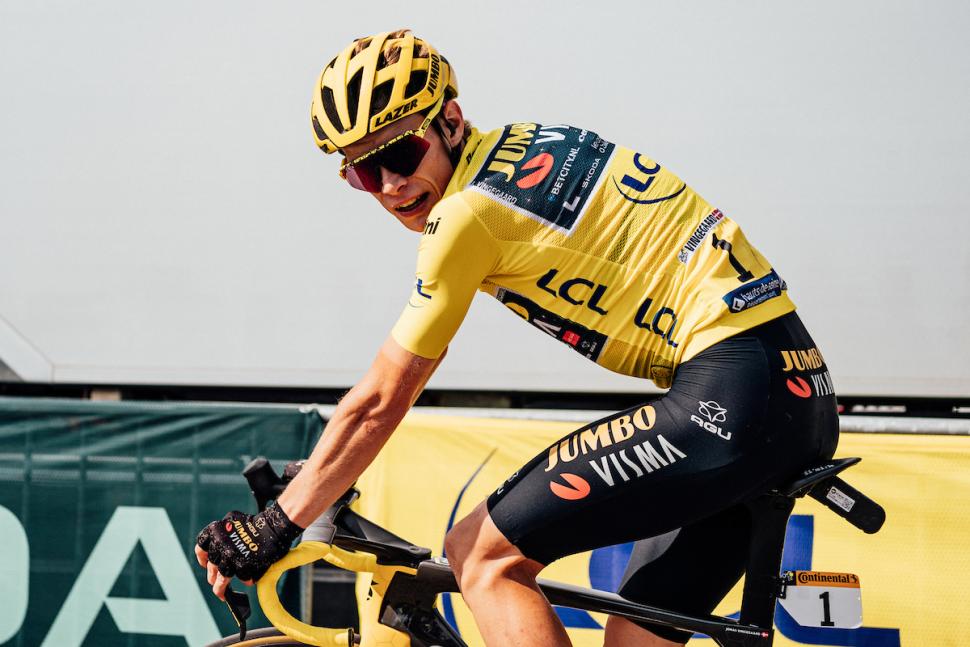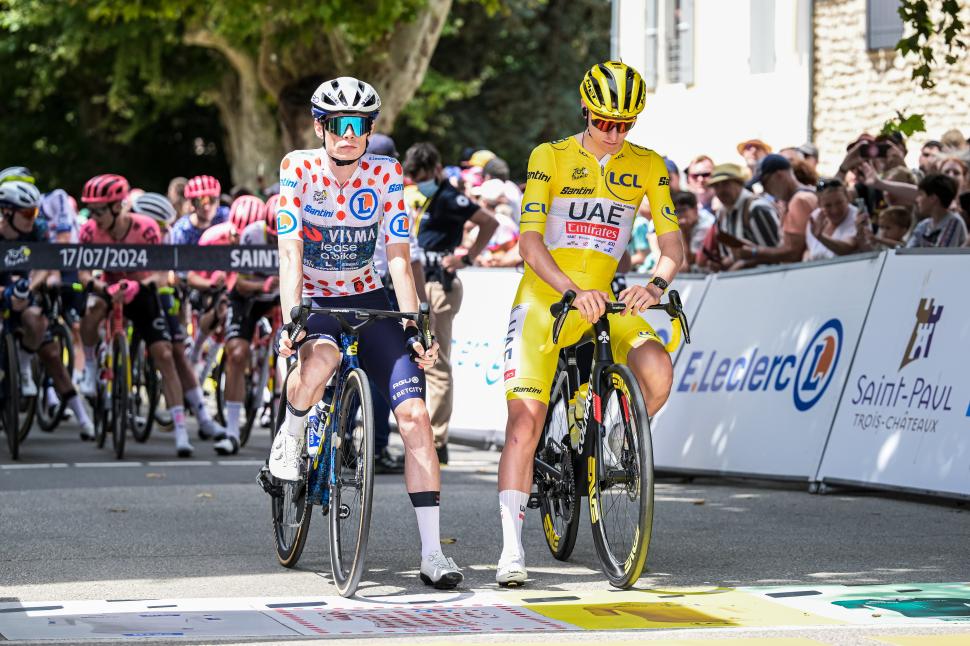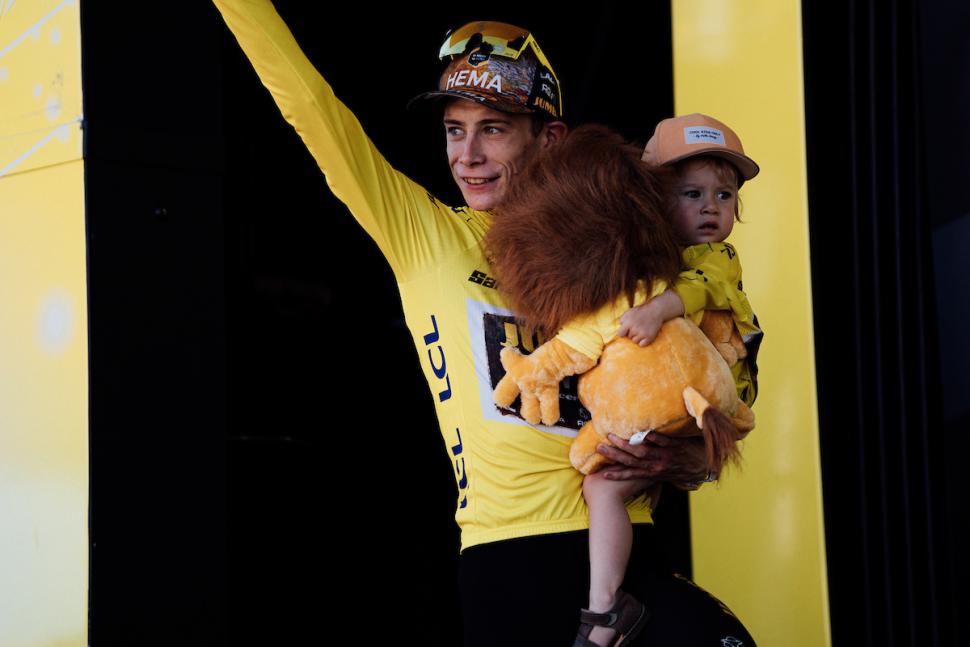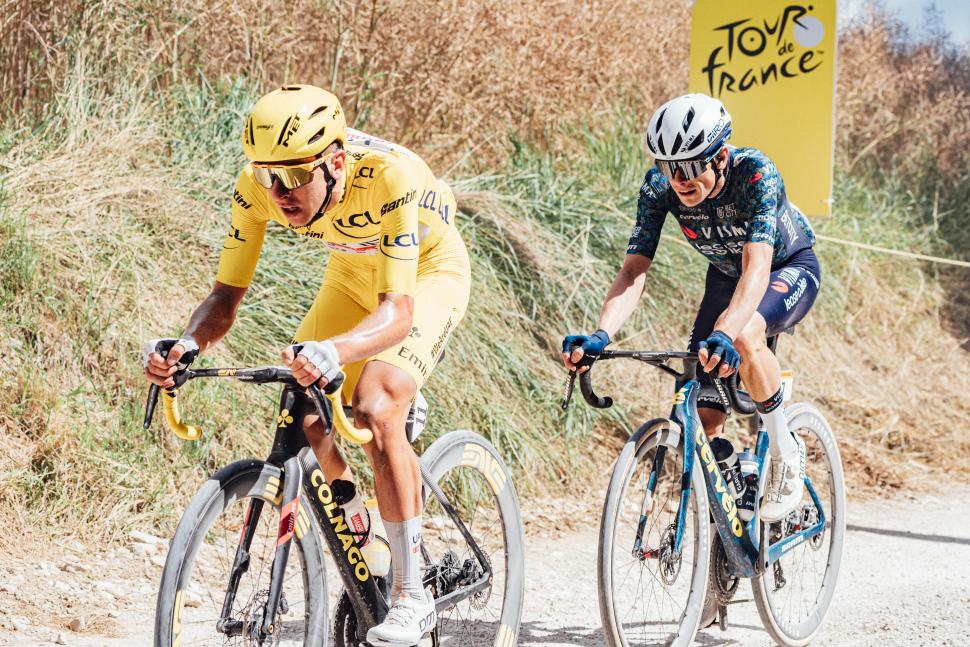- News
- Reviews
- Bikes
- Accessories
- Accessories - misc
- Computer mounts
- Bags
- Bar ends
- Bike bags & cases
- Bottle cages
- Bottles
- Cameras
- Car racks
- Child seats
- Computers
- Glasses
- GPS units
- Helmets
- Lights - front
- Lights - rear
- Lights - sets
- Locks
- Mirrors
- Mudguards
- Racks
- Pumps & CO2 inflators
- Puncture kits
- Reflectives
- Smart watches
- Stands and racks
- Trailers
- Clothing
- Components
- Bar tape & grips
- Bottom brackets
- Brake & gear cables
- Brake & STI levers
- Brake pads & spares
- Brakes
- Cassettes & freewheels
- Chains
- Chainsets & chainrings
- Derailleurs - front
- Derailleurs - rear
- Forks
- Gear levers & shifters
- Groupsets
- Handlebars & extensions
- Headsets
- Hubs
- Inner tubes
- Pedals
- Quick releases & skewers
- Saddles
- Seatposts
- Stems
- Wheels
- Tyres
- Health, fitness and nutrition
- Tools and workshop
- Miscellaneous
- Cross country mountain bikes
- Tubeless valves
- Buyers Guides
- Features
- Forum
- Recommends
- Podcast
news
 Jonas Vingegaard at 2023 Tour de France, stage 20 (Zac Williams/SWPix.com)
Jonas Vingegaard at 2023 Tour de France, stage 20 (Zac Williams/SWPix.com)“There are a lot of people smoking cigarettes every day”: Jonas Vingegaard says carbon monoxide method is like “smoking one cigarette” and claims he “never knew” it could be misused
Jonas Vingegaard has claimed that he was unaware that the controversial carbon monoxide rebreathing method deployed by his Visma-Lease a Bike team to test the effects of altitude training could be “misused” for performance enhancement purposes, stating that he will refrain from using the gas if it is banned by the UCI and WADA.
Conjuring shades of doping doctor Michele Ferrari’s infamous comparison between the use of banned blood booster EPO and the dangers of drinking ten litres of orange juice, the two-time Tour de France winner also downplayed the potential health effects of the much-discussed method, claiming it is akin to “smoking one cigarette” and noting that “there are a lot of people smoking cigarettes every day”.
Earlier this week, world cycling’s governing body, the UCI, called for the World Anti-Doping Agency (WADA) to “take a position” on the use of carbon monoxide inhalation in the peloton, after Escape Collective broke the news during this year’s Tour de France that UAE Team Emirates, Visma-Lease a Bike, and Israel-Premier Tech have access to a CO rebreather to test blood values.
Providing an accurate means of measuring key blood values such as haemoglobin (a protein that facilities the movement of oxygen in red blood cells), several pro squads have confirmed that they use CO rebreathers to track their riders’ progress during red blood cell boosting altitude training camps.
(ASO/Charly Lopez)
Both Tadej Pogačar and Jonas Vingegaard confirmed at the Tour that they had previously used carbon monoxide rebreathers, with Pogačar even dismissing the practice as a “pretty simple test” and claiming he’d never actually completed it, while Vingegaard told Danish reporters that there was “nothing suspicious” about the controversial rebreathing technique.
However, despite not breaking any current anti-doping rules, those very same carbon monoxide rebreathers also allow for precise dosing of the gas into the lungs, which could potentially assist riders’ bodies in producing more red blood cells and improve their aerobic capacity, enhancing their performance artificially – an alternative use of the equipment which all teams at the Tour denied using.
At its annual WorldTour seminar in Nice this week, the UCI requested that teams and riders avoid using “repeated CO inhalation”, clarifying that “only the medical use of a single inhalation of CO in a controlled medical environment could be acceptable”.
The governing body also officially called on WADA to “take a position on the use of this method by athletes”.
(Zac Williams/SWpix.com)
Speaking at a press conference on Thursday, Visma-Lease a Bike star Vingegaard claimed that he wasn’t even aware that another performance-enhancing use of CO even existed until it was reported in the media, reiterating that the Dutch squad only use the method for testing blood values at training camps.
“I understand if it’s misused, but I never knew that it could be misused,” the Dane said. “I think I said before that we only used it to test if the altitude camps are working or not.
"So, what I heard is that if you misuse it, it can be used instead of an altitude camp, and if you use it in that way, then they say there can be some health issues – but that’s not the way we use it.
“But with that said, also what I heard is that when you do this one time, it’s like smoking one cigarette. And I mean, there are a lot of people smoking cigarettes every day.”
Despite downplaying the potential dangers of CO inhalation, the two-time Tour winner nevertheless admitted that he would stop using the test if WADA acts on the UCI’s call to ban the method.
“It’s a difficult question, and I won’t take any side on that. Of course, I will follow what the UCI and WADA are saying about this,” the 27-year-old stage racing specialist said.
“So, if they will ban it, of course, I will never do it again.”
Vingegaard’s comments this week echo those of his Tour rival Tadej Pogačar, who claimed during July’s race that he had never even completed the test, despite it being used by UAE Team Emirates, while arguing that “it’s not like we’re breathing exhaust pipes”.
“It’s a test in altitude camp to see how you respond to altitude. You need to do this test, it’s like a two or three-minute-long test. You breathe into a balloon for one minute and then you see the haemoglobin mass, and then you need to repeat it two weeks after,” the Slovenian said when asked about the method at the Tour.
“But I did just the first part of the test. I never did the second part because the girl who was supposed to come after two weeks didn't come. It’s not like we’re breathing exhaust pipes every day in the cars. It’s just a pretty simple test to see how you respond to altitude training.”
(Zac Williams/SWpix.com)
At this year’s Tour, Pogačar’s UAE Team Emirates employers also denied that carbon monoxide was being used by the squad for “unethical purposes”.
“Carbon monoxide rebreathing is a method to assess total haemoglobin mass and has been used in altitude training and research for over 20 years. It is a well-established, safe, professional method that is backed by a very large amount of research,” the team said.
“We measure the haemoglobin mass at the start of an altitude training camp and at the end of the camp. In this way we minimise our athlete’s exposure to carbon monoxide and not the other way around.
“Any links to our team using this type of technology for unethical purposes are being made without any merit and without any facts or evidence to support them.”
However, another rider who has recently claimed that he only learned of the blood boosting effects of carbon monoxide through the press is Romain Bardet – though the French veteran did suggest that the technique could explain the recent jump in form of some riders.
“We see the studies. Anything is possible. I have never heard of anything but at the same time, I would not be surprised,” DSM-Firmenich PostNL climber Bardet, who is set to retire following next June’s Critérium du Dauphiné, said earlier this month.
“There is so much research being done with the idea of optimising performance. Ten years ago, there were lots of promises about altitude. Everyone was getting involved, it was a bit of a panacea. We know exactly where it can take us.
“It is not surprising that there are certain researchers, certain teams, certain cyclists who are looking elsewhere. There will always be the desire to seek competitive advantages.”
The 34-year-old continued: “Carbon monoxide could explain the trajectory of some people we didn’t know about a year, a year and a half ago, but it’s also a bit of an easy claim to make without looking at their trajectory.
“These processes are documented and it’s now up to the authorities to decide whether to ban them or not, to carry out checks. It’s totally futile, in such a competitive world with so many economic issues, to believe that it’s the goodwill and impeccable ethics of the riders and teams that will allow the sport to regulate itself healthily. It’s totally illusory.”
After obtaining a PhD, lecturing, and hosting a history podcast at Queen’s University Belfast, Ryan joined road.cc in December 2021 and since then has kept the site’s readers and listeners informed and enthralled (well at least occasionally) on news, the live blog, and the road.cc Podcast. After boarding a wrong bus at the world championships and ruining a good pair of jeans at the cyclocross, he now serves as road.cc’s senior news writer. Before his foray into cycling journalism, he wallowed in the equally pitiless world of academia, where he wrote a book about Victorian politics and droned on about cycling and bikes to classes of bored students (while taking every chance he could get to talk about cycling in print or on the radio). He can be found riding his bike very slowly around the narrow, scenic country lanes of Co. Down.
Latest Comments
- thax1 1 sec ago
I was just excited to learn that Grundig were still a going concern, let alone making stuff for bikes now! What's next, Blaupunkt power meters?!
- chrisonabike 1 hour 11 min ago
Nothing to do with cycling, and currently unclear as to what exactly happened. But a child is dead, a tram line isn't running services and ...
- Destroyer666 24 min 37 sec ago
Sidelining the point here a little bit, but I was just looking at a Rapha video about Lachlan Morton's latest incredible venture of riding 648km in...
- rogerwb 3 hours 24 min ago
It's not that simple: https://bsky.app/profile/christopher664023.bsky.social/post/3lahwh7u6rk2t
- wtjs 4 hours 2 min ago
Or, you can just look at them - it's pretty obvious when they're not going to work with a new chain. Then you can try them with old lengthened...
- NeilC575 4 hours 5 min ago
I bought 5 screw in storage hooks from local d.i.y store for £10. Does the same job 🤷♂️
- Bungle_52 7 hours 49 min ago
Well it looks like they've got a page now. It says they'll accept video evidence but I haven't been through the whole process. Looks very similar...
- eburtthebike 7 hours 59 min ago
Sorry, but the BBC is definitely tilting towards cycling after the Panorama debacle....
- mdavidford 8 hours 4 min ago
Unlikely. Not once he hears that it'll 'help Gore'.



Add new comment
19 comments
Have lost all faith in active cyclists. What a bullshit comment by Jonas. And Tadej saying they forgot the second part of the test - ha ha ha. The absolute cream of cycling is forgotten - ya right!!!! It would have been better if they had just shut up.
Did commuting to and from work on my bike for 46 years in the London traffic increase the number of my red blood cells? - my breathing is superb, I hardly had to breathe when I was a runner, and my resting heart rate is very low, and I mean very low, it was officially measured at 25 overnight during a 24-hour test by a London hospital, I'm 82.
I should get onto the Guinness Book of Records people then, as they have the world record slowest heart rate for a healthy person down as 26bpm, for one Daniel Green in 2014.
I would suggest that 24-hour hospital testing doesn't sound like a "healthy" person.
Although don't most definitions of resting heart rate exclude sleeping heart rate? So an overnight test probably wouldn't be accepted by GWR anyway.
Yeah, sleeping heart rates can be lower or higher than resting heart rates. A high sleeping heart rate can be a sign of an illness such as sleep apnea or it could mean that you're having spicy dreams.
I have started holding my breath for 5 x 30 seconds, that increases EPO, rebreathers not required.
At 77 my resting HR is 39 (NHS ECG monitor whilst sitting up in bed reading) and I thought that was excellent.
" Pogačar even dismissing the practice as a “pretty simple test” "
This is a fairly simple and *very* _standard_ test in sports physiology. CO rebreathing is the standard way physiology scientists (inc. sports scientists) measure absolute haemoglobin mass. It goes back over a hundred years!
This whole bruhaha now seems to have an element of lay-people hearing about something they don't understand for the first time and jumping to all kinds of strange assumptions.
Repeated use of CO rebreathing with careful scheduling of its use in training, with sufficient gap to any competition (cause CO _decreases_ your performance significantly while in your system) was theorised that it could give a performance boost similar to altitude training, or other forms of mild, chronic, hypoxia, due to stimulating production of more blood cells. I heard of this from sports scientists more than 10 years ago. I don't know of any studies that confirm the performance benefit of CO specifically, but it's been a while since I looked - but the sports scientists I knew thought it very plausible. It /should/ be same effect as altitude camps which /are/ shown to have some effect (hypoxic, hypobaric tents don't have great evidence - should work, but I guess poor implementation).
If you're getting worked up over this, you need to get worked up over altitude camps and hypobaric tents too.
[You need to measure absolute mass if you want to know if an athlete has less or more haemoglobin, because simple concentration (which can be done with a small blood sample and a centrifuge to get Hct) is confounded with plasma volume which can vary a lot (e.g., by drinking, or by not drinking and being dehydrated) - so just concentration on its own has a lot of noise and could mislead.]
The connection with smoking is that smokers can attain levels of carboxyhaemoglobin (CO-Hb = carbonmonoxyhaemoglobin = haemoglobin which can't transport oxygen from the lungs to muscles etc.) of 10% or more. The UCI is not going to ban smokers from competition in the same way as they're not about to test for ethanol in the blood, not least because they don't need to- the smokers are not going to be there at the start line. They can clearly accurately measure very low levels of CO-Hb, or it wouldn't be a good test for total red cell mass. I think the authorities would soon work out how to detect illicit use of carbon monoxide by any teams/ riders barmy enough to try it, and the existing methods of cheating look a lot safer. Some limit, like 'a couple of times a season' should solve this one!
I don't have the expertise to know if this technique is dubious or not but "there are a lot of people smoking cigarettes every day" is hardly a defence. There are a lot of people taking cocaine every day but that doesn't mean it would be okay for cycler racers.
The comment about cigarettes was probably daft, but not a good reason for road.cc to compare Vingegaard to Michele Ferrari.
Funny you say cyclists don't use cocaine but I'm sure when Eddie Merckx was riding that was one of the choice drugs used in the peloton. Allegedly it was widely used by numerous great cyclists along with other stimulants/amphetamines in that era.
I may not have expressed myself clearly, I meant that it would be okay for cycle racers because it's banned, rather than that it wouldn't be performance enhancing.Yes indeed cocaine has been very widely used in cycling pretty much since the start, the infamous "pot Belge" of the 70s and 80s (maybe earlier too?) was a confection of heroin, cocaine, caffeine and speed.
As an athlete you have to be very careful about what you eat for example what exactly is in the sports drinks and supplements you consume. That level of caution surely also applies to medical/scientific procedures that you may have to undergo as part of team training. CO rebreathing cannot reasonably be compared with having a cigarette - something that is not part of any professional training programme.
At least today it's a case of "more haste, less speed" (as that was replaced by steroids, EPO, blood doping...)
Nothing new etc. I guess nobody's been using strychnine since the early days of Le Tour, so there's that.
It's a standard technique. See my longer comment.
Are you going to ban altitude camps and hypobaric tents too? Cause they're all exploiting the same effect - chronic hypoxia to stimulate red blood cell production. How will you ban altitude camps? Will athletes be banned from being above a certain X metres altitude for more than Y days a year?
If anything, CO rebreathing at least allows athletes with little money to get access to the same effect that the big teams get by spending tens to hundreds of thousands per year on holidays/altitude camps in the high mountains.
The hotel on top of Teide is block-booked by the big cycling teams. Smaller teams have 0 chance even booking anything there off-season I suspect.
that was my Q about the line "those very same carbon monoxide rebreathers also allow for precise dosing of the gas into the lungs, which could potentially assist riders’ bodies in producing more red blood cells and improve their aerobic capacity, enhancing their performance artificially" - aren't altitude tents ariticial in the same way?
CO rebreathing, altitude camps, and altitude/hypobaric tents are all trying to exploit the same effect: The body producing more red-blood cells in response to chronic, mild hypoxia (reduced oxygen).
Staying at altitude has an effect - so the physiological effect definitely is there. Altitude/hypobaric tents /ought/ to similarly work, however AFAIK the evidence is not great that they actually work - given the physiological effect is real, that likely means altitude tents are just not very good at actually simulating altitude for a sustained period of time. At least, not the ones athletes are using, cause there are other tents (large ones) used for training pilots to recognise hypoxia which definitely do work over at least shorter time-spans.
CO rebreathing is just stimulating this same effect. And you don't need to go to spend 2+ weeks in an expensive hotel high up in the alps or Teide, exactly at a time of year when you're competing with the richest professional endurance sports athletes to book those rooms.
...while simultaneously managing to make it sound a lot worse than it probably is, given that the main problems with cigarettes are (a) their addictiveness, and (b) their carcinogenic nature, presumably neither of which apply to this.